Electronic device with cooling by a liquid metal spreader
- Summary
- Abstract
- Description
- Claims
- Application Information
AI Technical Summary
Problems solved by technology
Method used
Image
Examples
Example
[0077]FIGS. 6A and 6B show a first embodiment of the device according to the invention comprising two electromagnetic pumps each comprising a first and a second electromagnetic circuit generating a magnetic field, and electrodes transporting electrical current.
[0078]FIG. 6A clearly shows the following:[0079]un first magnetic circuit 40 comprising at least one bar made of magnetic material 41 and a permanent magnet 42,[0080]un first polymer frame 43,[0081]a first plate made of an insulating material 44 on which semiconductor components 52 are located,[0082]a bar made of deformable material 47,[0083]three electrodes 45, one of which is arranged on deformable material,[0084]a polymer seal 46 with support means 46′,[0085]a second plate made of insulating material 48,[0086]a second polymer frame 49,[0087]a second magnetic circuit 50,[0088]a heat sink 51,
a liquid metal circulation channel being made around the bar made of deformable material 52.
[0089]In one advantageous embodiment, the de...
Example
[0098]FIGS. 8A and 8B show a second embodiment of the device according to the invention, that corresponds to a power model comprising four electromagnetic pumps.
[0099]FIG. 8A clearly shows the following:[0100]two first magnetic circuits 60 and 61,[0101]a polymer frame 62,[0102]a first ceramic plate 63, on which electronic circuits 64 or several electronic components 65 are placed,[0103]a bar made of deformable material 68,[0104]electrodes 66, 66′, 69, 69′ and electrodes 67 placed on deformable material 68,[0105]a polymer seal 70 with support means 70′,[0106]a second ceramic plate 71,[0107]two second magnetic circuits 72 and 73,[0108]a finned heat sink 74,
a liquid metal circulation channel being made around the bar made of deformable material 68.
Example
[0109]FIGS. 9A and 9B show a third embodiment of the device according to the invention, that corresponds to a model with two superposed liquid metal circulation channels.
[0110]FIG. 9A clearly shows the following:[0111]a first finned heat sink 80,[0112]a first polymer frame 81,[0113]first magnetic circuits 82,[0114]a first ceramic plate 83 on which semiconductor components 84 are located,[0115]first electrodes 85,[0116]a first polymer seal 86, with support means 87,[0117]a second ceramic plate 88,[0118]a second polymer seal 90 with support means 91,[0119]second electrodes 92,[0120]three second bars made of deformable material 93,[0121]a third ceramic plate 95,[0122]second magnetic circuits 96,[0123]a second polymer frame 97,[0124]a second finned heat sink 98,
a first liquid metal circulation channel being made around first bars made of deformable material 92, and a second liquid metal circulation channel being made around second bars made of deformable material 93.
[0125]In order to de...
PUM
 Login to View More
Login to View More Abstract
Description
Claims
Application Information
 Login to View More
Login to View More - R&D
- Intellectual Property
- Life Sciences
- Materials
- Tech Scout
- Unparalleled Data Quality
- Higher Quality Content
- 60% Fewer Hallucinations
Browse by: Latest US Patents, China's latest patents, Technical Efficacy Thesaurus, Application Domain, Technology Topic, Popular Technical Reports.
© 2025 PatSnap. All rights reserved.Legal|Privacy policy|Modern Slavery Act Transparency Statement|Sitemap|About US| Contact US: help@patsnap.com



